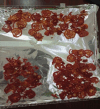A Comparative Analysis on the Variation of β-Carotene, Vitamin C and E Levels in Hydroponic and Soil-Based Fruits and Vegetables in Kiambu County, Kenya
- PMID: 40475981
- PMCID: PMC12138574
- DOI: 10.1002/fsn3.70403
A Comparative Analysis on the Variation of β-Carotene, Vitamin C and E Levels in Hydroponic and Soil-Based Fruits and Vegetables in Kiambu County, Kenya
Abstract
Antioxidants such as β-carotene, vitamin C, and E in fruits and vegetables (FAVs) have been associated with a reduction in non-communicable diseases because of their vital metabolic roles. However, their levels in foods could vary depending on the farming systems. Hence, this study examined the levels of β-carotene, vitamin C, and E in hydroponic and soil-grown spinach, tomatoes, and strawberries. A cross-sectional study with an analytical component was conducted to facilitate this comparison. Ten samples were collected from hydroponic farms and nine were from soil-based farms. The data was analyzed using SPSS (version 25). The level of vitamin C was significantly higher in hydroponically grown tomatoes (p = 0.008) and strawberries (p = 0.037) compared to those from the soil-based system. The level of vitamin E was significantly higher in hydroponic tomatoes, spinach, and strawberries (p ≤ 0.05) compared to those grown in the soil-based system. Β-carotene level was significantly higher only in the hydroponically grown spinach (p < 0.05) unlike tomatoes, and it was not detected in both hydroponic and soil-based strawberries. In conclusion, the findings of this study show a remarkable nutrient accumulation in some FAVs grown in the hydroponic farming system leading to a higher nutrient density compared to those grown in the soil-based systems. Training and provision of resources for hydroponic farming could be done to scale up production in the country to promote food security by obtaining nutritious FAVs within a short period throughout the year.
Keywords: antioxidants; fruits and vegetables; hydroponic system; nutrient accumulation; soil‐based system.
© 2025 The Author(s). Food Science & Nutrition published by Wiley Periodicals LLC.
Conflict of interest statement
The authors declare no conflicts of interest.
Figures
Similar articles
-
Controlled comparisons between soil and hydroponic systems reveal increased water use efficiency and higher lycopene and β-carotene contents in hydroponically grown tomatoes.Sci Hortic. 2021 Mar 15;279:109896. doi: 10.1016/j.scienta.2021.109896. Sci Hortic. 2021. PMID: 33731973 Free PMC article.
-
[Dietary sources of vitamin A, C, E and beta-carotene in a adult Mediterranean population].Gac Sanit. 1999 Jan-Feb;13(1):22-9. doi: 10.1016/s0213-9111(99)71318-x. Gac Sanit. 1999. PMID: 10217703 Spanish.
-
Occurrence and Risk Assessment of Pesticides, Phthalates, and Heavy Metal Residues in Vegetables from Hydroponic and Conventional Cultivation.Foods. 2024 Apr 10;13(8):1151. doi: 10.3390/foods13081151. Foods. 2024. PMID: 38672824 Free PMC article.
-
Techniques for measuring vitamin A activity from β-carotene.Am J Clin Nutr. 2012 Nov;96(5):1185S-8S. doi: 10.3945/ajcn.112.034603. Epub 2012 Oct 10. Am J Clin Nutr. 2012. PMID: 23053556 Review.
-
Mechanisms of action of antioxidants as exemplified in vegetables, tomatoes and tea.Food Chem Toxicol. 1999 Sep-Oct;37(9-10):943-8. doi: 10.1016/s0278-6915(99)00086-1. Food Chem Toxicol. 1999. PMID: 10541449 Review.
References
-
- Abidin, N. N. Z. , and Ikhwan F. B. F.. 2024. “Comparative Analysis of Vitamin C Content in Fruit Juices Available in Local Supermarkets Using DCPIP Method.” International Journal of Enterpreneurship and Management Practices (IJEMP) 7, no. 28: 460–471. 10.35631/IJEMP.728032. - DOI
-
- Agbede, T. M. , Adekiya A. O., Ale M. O., Eifediyi E. K., and Olatunji C. A.. 2018. “Soil Properties, Growth, Fruit Yield, Mineral, Lycopene and Vitamin c Contents of Tomato (Lycopersicon esculentum Mill) Grown With Green Manures and NPK Fertilizer.” Agriculturae Conspectus Scientificus 83, no. 4: 291–297.
-
- Aires, A. 2018. Hydroponic Production Systems: Impact on Nutritional Status and Bioactive Compounds of Fresh Vegetables. Vol. 4, 12. IntechOpen. 10.5772/intechopen.73011. - DOI
-
- Amalya, J. T. , and Sumathy J. H.. 2014. “Analysis of Carotenoid Pigments Extracted by Column Chromatography From the Leaves and Flowers of Peltophorum pterocarpum by Thin Layer Chromatography, Mass Spectrometry and Nuclear Magnetic Resonance Spectroscopy.” Unique Research Journal of Chemistry 02, no. 3: 11–17.
-
- Amusan, O. , and Adeleke O.. 2023. “Involvement of Youths in Soilless Agriculture in Ogun State, Nigeria.” Nigerian Journal of Rural Extension and Development 15: 7.
LinkOut - more resources
Full Text Sources





